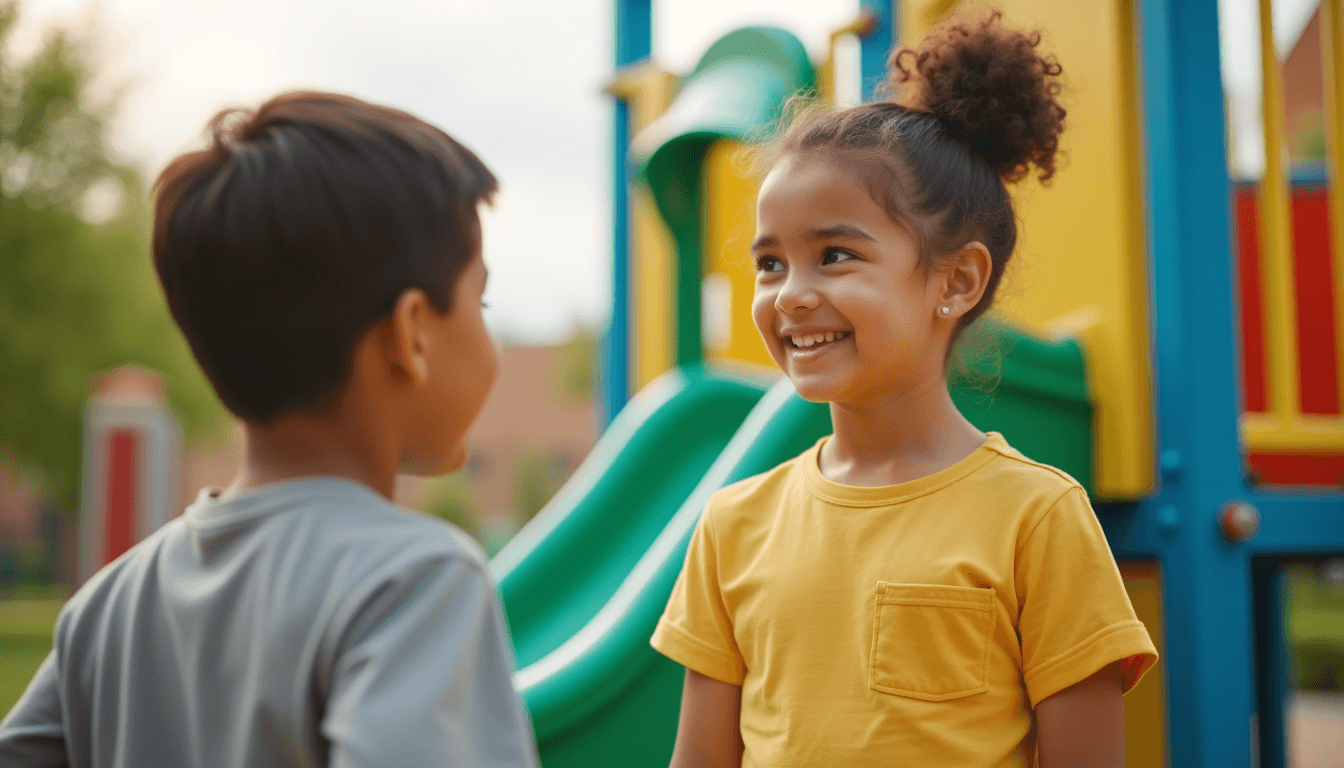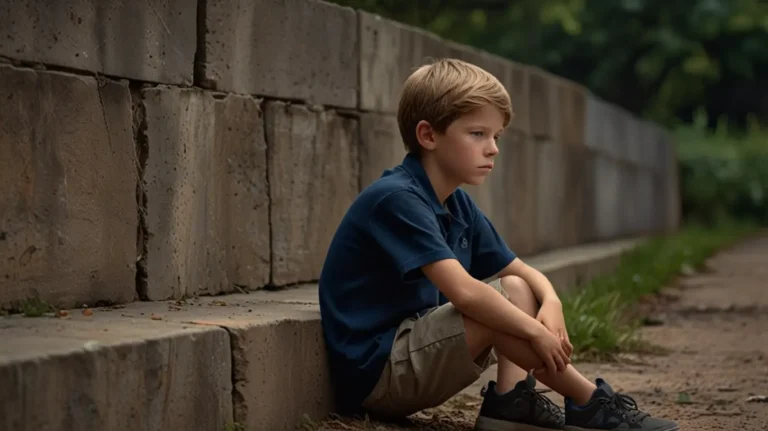Did you know that 67% of children struggle to speak up for themselves in challenging situations?
That’s right—whether it’s dealing with playground conflicts, classroom participation, or standing up to peer pressure, many kids find it difficult to express their thoughts and feelings effectively. But here’s the good news: kid’s assertive behaviour examples can help children develop this crucial life skill.
At Lulabico, we’re here to support modern parents with practical resources that make teaching assertiveness easier and more effective.
Teaching assertiveness for kids doesn’t have to be complicated. Just like learning to ride a bike, assertiveness is a skill that improves with practice and proper guidance. Through simple, real-world examples and a proven 3-step approach, your child can learn to communicate confidently while respecting others.
Ready to help your child master the art of assertive communication for kids? Let’s explore practical examples and techniques that work in everyday situations, focusing on the different types of assertiveness and how to distinguish between passive, assertive, and aggressive communication.
Understanding Assertive Behaviour Through Real Examples
Let’s explore real-world assertive behaviour examples that children encounter daily. Understanding these situations helps kids recognize when and how to use assertive communication effectively.
Playground Scenarios: Standing Up for Yourself
Picture this: Two children reach for the same swing at the same time. Instead of pushing or walking away sadly, an assertive child might say, “I see we both want the swing. How about we take turns? I can count to 50 for each turn.” This approach shows respect while clearly expressing needs and demonstrates effective assertive speech.
Classroom Examples: Speaking Up Respectfully
In the classroom, assertive behaviour examples include raising your hand and saying, “I don’t understand this problem. Could you please explain it again?” rather than sitting quietly confused. Studies show that children who practice assertive communication in class are more likely to build stronger relationships and feel in control of their learning. This is a key aspect of teaching assertiveness to elementary students.
Family Situations: Expressing Needs Clearly
At home, assertiveness means expressing feelings and needs directly. For instance, when a sibling takes toys without asking, an assertive response would be: “I feel angry when you take my toys without asking. I would like you to ask first next time.” This is an excellent example of using “I” statements, a crucial element of assertive communication.
Here are the three main communication styles for kids:
- Passive: Giving in and staying quiet to keep peace
- Aggressive: Using force or harsh words to get their way
- Assertive: Expressing needs clearly while respecting others
Remember, assertive behaviour isn’t about winning or losing – it’s about finding solutions that work for everyone. When children learn to communicate assertively, they develop confidence in expressing their thoughts while maintaining positive relationships and setting personal boundaries.
Master the 3-Step Assertiveness Formula
Teaching assertiveness for kids becomes easier when you break it down into simple, actionable steps. Let’s master this powerful communication approach that helps children express themselves effectively.
Step 1: Identify Your Feelings
Start by helping your child recognize and name their emotions. Studies show that children who can identify their feelings are better equipped to express themselves assertively. Encourage your child to pause and ask themselves: “How am I feeling right now?” This self-awareness forms the foundation of assertive behaviour and contributes to overall emotional health.
For example, imagine your child feels upset because a friend excluded them from a game. Instead of acting out or staying silent, they could first identify their emotion, saying: “I feel left out.” By naming their feeling, they begin to take control of the situation, setting the stage for assertive communication.
Step 2: Express Your Needs Clearly
The key to clear expression lies in using “I” statements. This technique is proven to be non-judgmental and helps avoid blame or criticism. Here’s the simple formula for assertive communication examples sentences:
- Start with “I feel…”
- Add “when you…”
- Follow with “because…”
For instance, if a sibling takes your child’s toy without asking, they could say: “I feel upset when you take my toy because I was still playing with it.” This approach focuses on their feelings and the specific action, making it more likely that the other person will listen without becoming defensive.
Another scenario: In the classroom, if another student interrupts them during group work, they might say: “I feel frustrated when you talk over me because I didn’t get to share my idea.” Teaching kids to communicate this way promotes mutual respect and understanding
Step 3: Make Specific Requests
The final step involves making clear, actionable requests. Research indicates that children who learn to make specific requests are more likely to have their needs met while maintaining positive relationships. Instead of saying “Stop it!” teach your child to say: “I would like you to ask before borrowing my things.”
For example, if a friend is borrowing their belongings without permission, they could say: “I would like you to ask before borrowing my things.” Or, if another child cuts in line at the playground, they might assertively say: “I would like you to wait for your turn like everyone else.”
Remember, assertive behaviour examples work best when practiced regularly. When children use these steps, they learn to communicate their thoughts and feelings while respecting others’ rights and feelings. This balanced approach helps them build stronger relationships and develop greater self-confidence.
The Power of Regular Practice
Remember, assertive behavior examples work best when practiced regularly. Whether at home, school, or on the playground, consistent practice of these steps builds confidence and resilience. When children use this 3-step formula, they learn to communicate their thoughts and feelings effectively while respecting others’ rights and emotions.
Mastering assertiveness for kids equips them with a balanced approach to communication, helping them build stronger relationships, navigate conflicts, and develop greater self-confidence that lasts a lifetime.
Practice Assertive Body Language
Body language often speaks louder than words when it comes to assertive communication. Teaching children to use assertive body language helps them express their feelings and needs confidently without appearing aggressive or shy. Research shows that kids who maintain proper posture, use appropriate gestures, and make eye contact not only appear more confident but are also more likely to have their messages heard and respected. Let’s explore some practical ways to help children master assertive body language.
The Power Pose Technique
Standing tall can actually make you feel more confident! The power pose technique has shown remarkable results in boosting children’s self-esteem and promoting assertive communication. In one study, children who practiced power poses for just one minute daily reported higher self-confidence and better relationships with teachers and peers. Power poses are simple yet effective assertive communication activities for kids.
Try teaching your child these fun and empowering poses:
- The Wonder Woman Pose
Stand with feet hip-width apart and hands placed firmly on hips. This pose exudes confidence and helps children feel ready to tackle any challenge.
- The Superhero Pose
Plant feet firmly on the ground and raise one fist high into the sky as if they’re ready to save the day. This is a great way to energize your child and help them feel assertive.
- The Performer Pose
Stand tall with arms stretched into a wide “V” shape above the head. This pose symbolizes victory and is perfect for kids who might need a quick confidence boost before speaking up.
Encourage children to practice these poses daily, especially before situations where they need to assert themselves, such as asking for help, presenting in class, or addressing conflicts.
Eye Contact and Facial Expressions
Eye contact is a key component of assertive communication. It helps children appear engaged, confident, and trustworthy. Studies indicate that maintaining eye contact not only improves understanding of nonverbal cues but also strengthens relationships by making communication more personal and meaningful.
Here are some tips to help children develop better eye contact:
• Start small: Encourage your child to practice making eye contact during short conversations with family members. Gradually increase the duration as they become more comfortable.
• Practice with a mirror: Have your child stand in front of a mirror and make eye contact with their reflection. This helps them become aware of their expressions and builds their comfort level.
• Look at the face’s general direction: For kids who find direct eye contact overwhelming, suggest they focus on the general area of the person’s eyes, like the forehead or nose, to ease into the habit.
Facial expressions also play a big role in assertive communication. Teach children to keep their faces neutral but friendly, avoiding frowns or overly tense expressions, which might convey anger or discomfort.
Voice Tone and Volume Control
A calm, clear voice is another vital tool for assertive communication. It helps children convey confidence without coming across as aggressive or timid. Striking the right balance in tone and volume ensures their message is heard and understood.
Here’s how to guide your child in mastering voice control:
• Practice calm, steady speaking: Encourage your child to speak slowly and clearly, avoiding rushed or mumbled words. This conveys self-assurance.
• Avoid shouting or whispering: Teach your child to speak at a moderate volume—loud enough to be heard but not so loud as to seem intimidating.
• Use role-playing: Practice scenarios at home where your child can adjust their tone and volume based on the situation, such as requesting a turn on the swings or resolving a sibling disagreement.
The Power of Combined Assertive Body Language
Remember, assertive body language works best when combined with clear, respectful speech. For instance, a child standing tall in a Wonder Woman pose, maintaining gentle eye contact, and saying, “I feel upset when you don’t include me because I want to be part of the group,” demonstrates confidence without being confrontational.
By integrating confident posture, steady eye contact, and a clear voice, children can communicate their needs effectively while maintaining respect for others. This balanced approach not only helps them express themselves but also fosters stronger relationships and builds lasting self-confidence.
Incorporating these simple techniques into daily practice can make a big difference in teaching assertiveness for kids. Whether they’re preparing for a classroom presentation, handling conflicts on the playground, or speaking up at home, assertive body language will give your child the tools they need to communicate successfully and confidently.
Role-Play These Common Situations
Role-playing provides a safe space for children to practice assertive communication before facing real challenges. In fact, studies show that children who regularly practice assertive responses through role-play are better equipped to handle difficult situations. This makes role-playing one of the most effective assertiveness activities for students.
Dealing with Bullying Assertively
When facing bullying, children need clear, practiced responses. Research indicates that kids who can defend themselves confidently through verbal communication are less likely to be targeted by bullies. Here’s a proven approach:
- Use a strong, calm voice
- Maintain eye contact
- State the problem clearly
- Make a specific request
- Seek help if needed
Saying No to Peer Pressure
One in five school-age children report experiencing peer pressure. Teaching kids to handle this pressure assertively starts with practicing simple, effective responses:
- “No thank you, I don’t want to do that”
- “I’m not comfortable with this”
- “That doesn’t work for me”
- “I’ll pass on this one”
These assertive phrases help children in saying “no” and setting boundaries effectively.
Asking for Help When Needed
Creating awareness about when and how to seek help is crucial for assertive behaviour. Studies show that children often hesitate to tell adults about problems because they worry about being labeled as tattletales.
To overcome this, teach your child to identify “safe people” at school – teachers, counselors, or other trusted adults who can help when needed. Practice using simple phrases like “Can we talk?” or “I need help with something.” Remember to reinforce that seeking help is a sign of strength, not weakness.
For maximum effectiveness, set aside regular practice time to role-play these situations. Create realistic scenarios based on your child’s daily experiences, and switch roles occasionally to help them understand different perspectives. This hands-on practice helps children build confidence in their assertive communication skills and is one of the fun ways to teach assertiveness.
Conclusion
Assertive behavior empowers children to express themselves confidently while respecting others. Through simple steps like identifying feelings, making clear requests, and maintaining positive body language, children can develop this essential life skill. Research shows that kids who master assertive communication build stronger relationships, handle challenging situations effectively, and develop lasting confidence.
Practice makes perfect when it comes to assertiveness for kids. Regular role-playing sessions, combined with real-world examples and proper body language techniques, create a strong foundation for confident communication. Parents and educators play a crucial role in providing opportunities for children to practice these skills in safe, supportive environments.
Remember that assertiveness development takes time and patience. Each small step—from maintaining eye contact to speaking up in class—builds your child’s confidence and communication abilities. Start with simple situations and gradually progress to more challenging scenarios, celebrating progress along the way.
With consistent practice and expert resources from Lulabico, your child’s journey toward assertive communication will contribute to improved social skills, emotional boundaries, and stronger self-esteem. Be sure to explore our other posts on relevant topics to continue supporting your child’s mental and emotional growth every step of the way.




